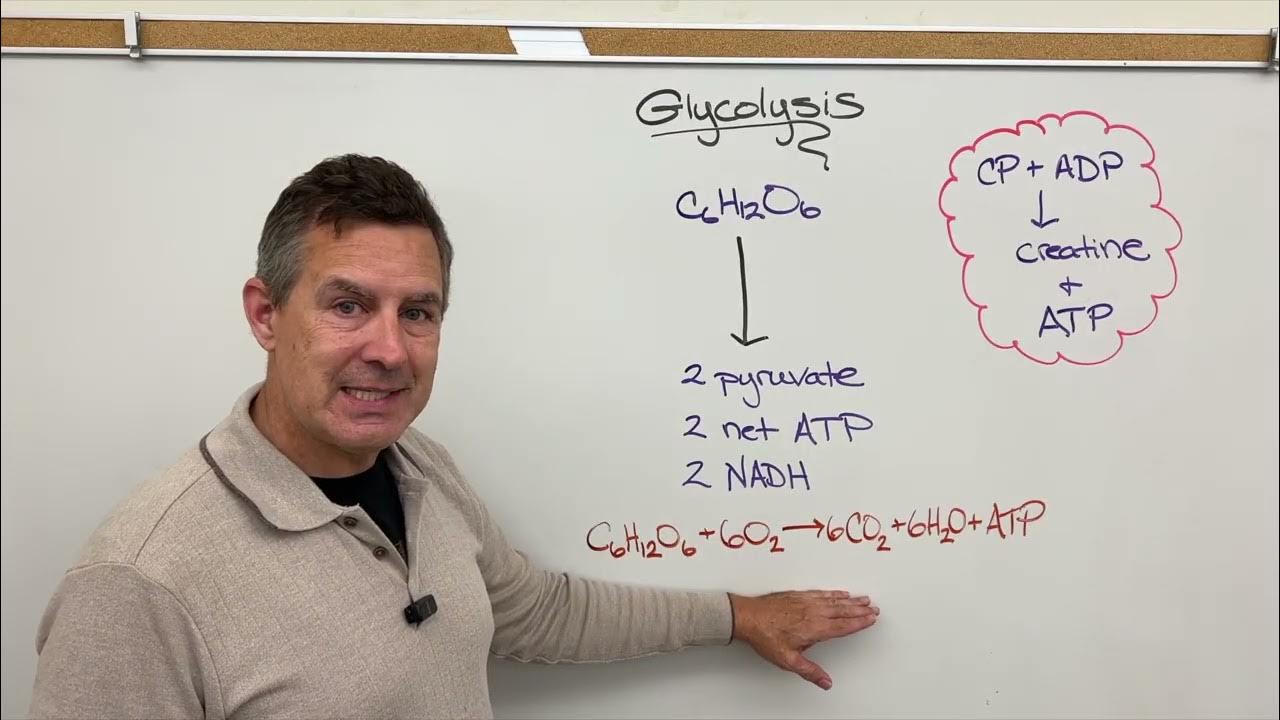Fosforilação oxidativa e cadeia transportadora de elétrons - Fisiologia Humana
Summary
TLDRThis video explains the intricate process of the electron transport chain and oxidative phosphorylation in cellular respiration. It describes how electrons from NADH and FADH2 power proton pumps across the mitochondrial membrane, creating a gradient used by ATP synthase to generate ATP. The process is compared to a hydroelectric plant, with protons flowing through ATP synthase to create energy. The role of oxygen as the final electron acceptor and the production of water are also covered. In total, each glucose molecule generates up to 32 ATP molecules through these processes, powering essential cellular functions.
Takeaways
- 😀 The electron transport chain (ETC) and oxidative phosphorylation are crucial for producing large amounts of ATP in the human body.
- 😀 The process of electron transport is similar to how a hydroelectric power plant works, with energy generated through the movement of protons across mitochondrial membranes.
- 😀 The ETC involves the mitochondrial membranes, including the inner and outer mitochondrial membranes, and a series of proteins known as the electron transport chain complexes.
- 😀 The ATP synthase enzyme is responsible for producing ATP through oxidative phosphorylation, utilizing the proton gradient generated by the ETC.
- 😀 Protons are pumped against their concentration gradient from the mitochondrial matrix into the intermembrane space, requiring energy to do so.
- 😀 The process starts with NADH donating electrons to complex I, which leads to the conversion of NADH to NAD+ and the pumping of protons into the intermembrane space.
- 😀 Complex II does not pump protons, but transfers electrons to coenzyme Q, which then passes the electrons to complex III and so on.
- 😀 Oxygen is the final electron acceptor in the ETC, forming water when it binds with electrons and hydrogen ions.
- 😀 Reactive oxygen species (ROS) can form during electron transfer, which can cause damage to molecules such as DNA, necessitating protective mechanisms in the body.
- 😀 ATP synthesis occurs through the ATP synthase enzyme, which uses the proton gradient to convert ADP and inorganic phosphate into ATP.
- 😀 The energy from the proton gradient and the resulting ATP synthesis is analogous to how a hydroelectric dam uses water flow to generate power.
Q & A
What role does the electron transport chain (ETC) play in ATP production?
-The electron transport chain is crucial for ATP production as it creates a proton gradient across the mitochondrial inner membrane, which is essential for the generation of ATP through oxidative phosphorylation.
How does the electron transport chain resemble a hydroelectric plant?
-The process of generating ATP through the electron transport chain is similar to a hydroelectric plant, where water is pumped to a higher level and then released to produce energy. In cells, protons are pumped across the membrane and flow back to generate ATP.
What is the significance of proton pumping in the mitochondria?
-Proton pumping creates a concentration gradient, with more protons in the intermembrane space than in the mitochondrial matrix. This gradient is necessary for ATP production, as protons flow back through ATP synthase, driving the conversion of ADP to ATP.
What are the main components involved in the electron transport chain?
-The electron transport chain consists of four protein complexes (I, II, III, IV), coenzyme Q, and cytochrome C. These components work together to transfer electrons and pump protons across the mitochondrial membrane.
How is energy released in the electron transport chain?
-Energy is released as electrons move through the protein complexes, and this energy is used to pump protons from the matrix into the intermembrane space, creating an electrochemical gradient.
What is the role of oxygen in the electron transport chain?
-Oxygen serves as the final electron acceptor in the electron transport chain. It combines with electrons and protons to form water, which is crucial for the continuation of the chain and preventing backup of electrons.
What is chemiosmosis, and how is it related to ATP production?
-Chemiosmosis refers to the process where protons flow through ATP synthase, causing a rotation that leads to the formation of ATP. This process uses the energy stored in the proton gradient generated by the electron transport chain.
How does ATP synthase work to produce ATP?
-ATP synthase has two parts: F0 and F1. Protons flow through the F0 portion, causing it to rotate. This rotation induces conformational changes in the F1 portion, enabling it to synthesize ATP from ADP and inorganic phosphate.
How much ATP is produced from one molecule of glucose in cellular respiration?
-A total of 32 ATP molecules are produced from one molecule of glucose in cellular respiration, including ATP generated in glycolysis, the Krebs cycle, and oxidative phosphorylation.
What is the potential danger of reactive oxygen species (ROS) produced during the electron transport chain?
-Reactive oxygen species (ROS) can cause damage to cellular molecules, including DNA, lipids, and proteins, leading to oxidative stress and cellular damage. The body has systems in place to minimize these effects.
Outlines

This section is available to paid users only. Please upgrade to access this part.
Upgrade NowMindmap

This section is available to paid users only. Please upgrade to access this part.
Upgrade NowKeywords

This section is available to paid users only. Please upgrade to access this part.
Upgrade NowHighlights

This section is available to paid users only. Please upgrade to access this part.
Upgrade NowTranscripts

This section is available to paid users only. Please upgrade to access this part.
Upgrade NowBrowse More Related Video

Cellular Respiration

Cellular Respiration (Electron Transport Chain) - animated

Oxidative Phosphorylation | Respiration | Revision for Biology A-Level and IB

AP Bio - Cellular Respiration - Part 1

Cellular Respiration Part 3: The Electron Transport Chain and Oxidative Phosphorylation

8A-Introduction to Cellular Respiration
5.0 / 5 (0 votes)